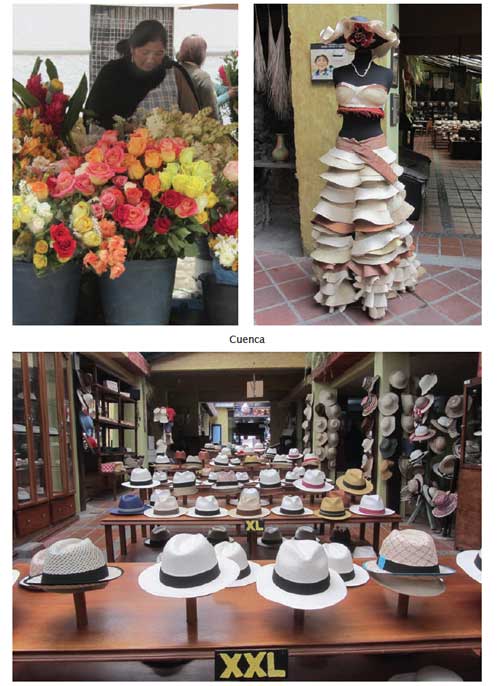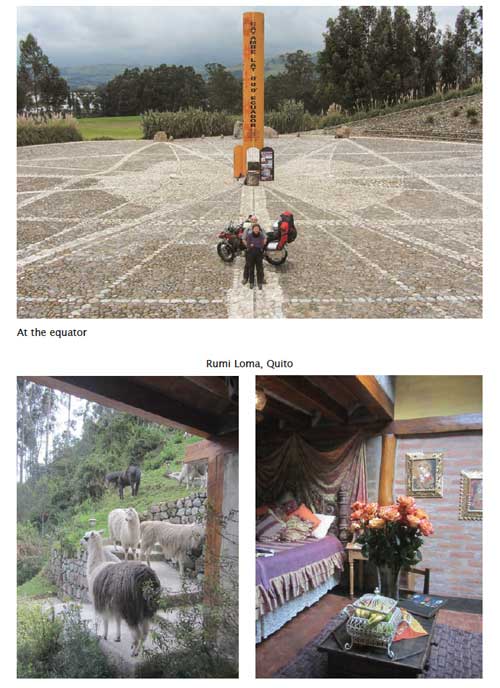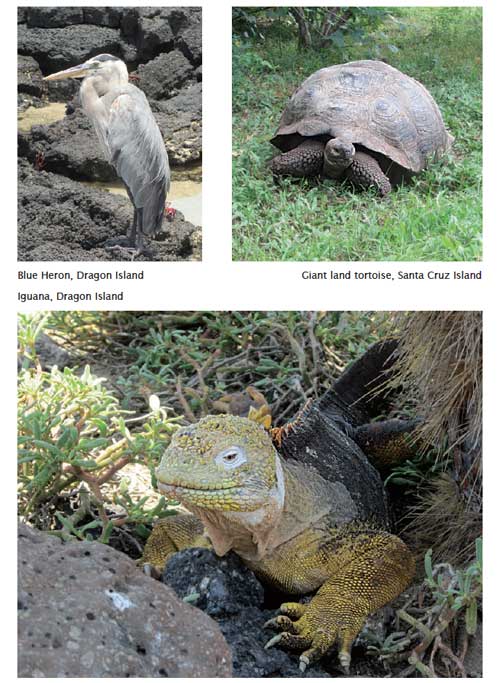
8 – 21 March 2012
Brian: What a difference a country makes. We get to the Ecuador border, get stamped in and then are sent to the SOAT counter to buy our insurance. It takes a few minutes and costs just $3 for a month. No chance for corrupt officials to rip us off, just modern efficiency.
Customs is a five-minute ride down the Pan American Highway, in the centre of the town. We’re invited into an air-conditioned office to fill out the forms, a pleasure on this hot day. For the records they need copies of the bike’s rego papers, my passport and licence and they are most impressed that we have all three. A couple of stamps and we’re in.
We ride through small towns where the indigenous Saraguro women dress in the traditional multi-coloured skirts, black shawls and white felt hats. These hats date back to the woollen hats these people wore in the days before the Incas. The hills of Ecuador are green, the air clear and cool — a real respite from the heat and dust of Peru. There’s been a lot of rain here and there are plenty of overland detours around washed out roads.
Ian Moor, our good friend Keith Moor’s brother, meets us at the Alternative Hostel in Cuenca. Ian’s organised a room with a private bathroom for us. We have the eight bunk beds in the room all to ourselves. Ian hit retirement age and had two options: one was to sit at home on the pension; the other was to rent out his house and hit the road, living off his rent. He hit the road and has been travelling through South America for months, taking his time. He knows Cuenca well and is the perfect guide.
The three of us wander along the narrow cobblestoned streets, through the small squares, past the old 16th century church and the massive ‘new’ church, built in the 19th century to seat 9,000 people.

There are huge buckets filled with colourful roses with the most delicate perfume in the flower market. I buy a long stemmed red rose for Shirl for just 25 cents. It’s cheap by our standards, but I know I’ve paid gringo prices. That doesn’t matter when I think of the brownie points I’ve earned with my wife.
At the vegetable market women are brushing small children with branches that could be herbs. The kids obviously don’t like it, crying as the branches brush their tummies and their heads. The mums just look on, completely unconcerned, so it must be good for them.
I always thought Panama hats originated in Panama, but there’s a factory here making these white sombreros. We watch the hat-makers sewing, blocking and bleaching the hats. I try one on and Shirl assures me it looks good. I can pack plenty of things on the bike but a Panama hat isn’t one of them.
Shirley: We don’t feel unsafe in Cuenca and that could be because of the security guards everywhere. Even the local hairdresser, chemist and toy shop have an armed guard standing in the doorway. I’m more than a little taken aback when we see a young man, dressed in jeans standing outside a shop carrying his handgun. He’s just passing the time of day with another bloke. It’s a very different world.
Brian: Getting out of Cuenca isn’t easy. Even with the GPS, the regular paper map, and the directions from helpful locals it takes us more than two hours to get on the road to Quito, the capital of Ecuador.
We ride round in circles because of major road works in the centre of the city. It looks like they’re putting in an underground railway or another roadway. It doesn’t matter which road we take, we end up at a dead end overlooking the massive hole in the ground.
The GPS tells us we’ll take 14 hours to cover the 400 odd kilometres. This can’t be right. Eventually we get on the right road and encounter more crazy drivers. An idiot in a Hyundai 4WD screams past us only to stop in a little town. A few minutes later he’s behind us again — I mean right up our exhaust pipe — and then screams past again. I have a little play with him for a few kilometres, there’s no way he can outrun us and I can see him getting more ragged and taking enormous risks overtaking trucks on blind corners. I let him go, much to Shirl’s relief.
Our tyres are just about stuffed and I have plans to replace them in Quito. It can’t come soon enough. When we hit the centre of Quito it starts to rain and the front tyre starts to slip around on the cobblestoned streets in the old part of town.
Our hotel is just behind Music Street, a strip of vibrant bars and restaurants, all with live music. The local police band is playing at the corner. Sitting in a bar we hear a cacophony of noise as a marching brass band comes down the street followed by dancers in their full multi-coloured skirts.
In Santa Domingo Square there are two local musicians playing the Andean pipes — one set as tall as the man playing it. The sound is brilliant. I’ll have to find space for the CD Shirl can’t resist.
Shirley: After a night in the old part of town we’re moving to a luxury B&B Rumi Loma in the hills at the back of town. We’ve been introduced to the owners, Amber and her Ecuadorean mountain climber husband Oswaldo over the internet by friends in Melbourne. Even with mate’s rates it’s out of our budget, but hang the expense.
It’s so luxurious. There’s a small sitting room with a day bed and open fire. The bedroom has the biggest bed with masses of pillows and comforters. The bathroom has a sunken brass bath and fluffy towels. This place is a knock out — the perfect place to recharge the batteries. We just hang out. There are peacocks in the garden and llamas grazing on the lawns. At night, while we dine in the restaurant overlooking the lights of Quito the staff turn the bed down and slip in hot water bottles to take the chill of the sheets.
Brian: The bike needs some TLC here. Amber has helped us book the bike into the BMW dealer for a service and new tyres. We ride in and there’s a sign on the parking space welcoming the new customers from Rumi Loma. There have been plenty of bad reports about this BMW dealer on the web. Travellers have told us the people here are very difficult and don’t speak English. Our experience couldn’t be more different. Quite a few of the staff speak English and they couldn’t be more helpful with the things we need sorted for the bike and getting us some new tyres, the only set available for our bike in all of Ecuador.
Shirley: Now it’s my turn for some TLC. I grew my hair before this trip thinking the long hair would be easier to look after. Well, it’s giving me the shits, to put it mildly. I’ve been tossing up getting it cut. Every time I mention it to Brian he gets more and more exasperated. Should I cut it? Should I colour it? He just wants me to make a decision and get it over and done with. Being bald he doesn’t understand the quandary I face.

Decision made — I’m going to cut if off. Amber takes me to her hairdresser and explains the type of cut I want. I get the best haircut and a manicure. Amber insists that I need some product for my new cut. The hairdresser throws in a large pot of ‘Gorilla Snot’. It’s sickly yellow gel with a sketch of a gorilla on the label. He has, of course, snot coming out of his nose. It looks disgusting but actually smells quite nice and does its job. Total cost just $15 for the lot — cut, manicure and ‘Gorilla Snot’.
•
It’s now mid-March and our commitment to be in Texas the first week in May is looming. There’s still a long road ahead of us with some places that can’t be missed in this part of the world — the Galapagos Islands is one of them.
Leaving the bike at Rumi Loma, we fly out of Quito heading for Santa Cruz Island that’ll be our base for four days. This pristine environment is home to some of the most exotic wildlife in the world. They are very thorough checking all the luggage that’s taken onto the island. Everything is x-rayed before we leave Quito and searched again on arrival. The quarantine officer opens my backpack and finds Ken and Millie, our mascots, in the top. ‘Are you trying to smuggle animals into Galapagos, madam?’ he asks. Funny man.
Brian: Charles Darwin visited here in his ship, the Beagle. The animals he saw helped him determine his theory of evolution. The Charles Darwin Research Centre is a great place to get an overall view of the species found here. The star turn at the research centre is Lonesome George, the oldest known giant tortoise. He’s more than 100 years old and the last member of his subspecies. They can’t find a suitable mate for George, so he just hangs out on his own in his enclosure, a lonely old man without a companion. (George has since died — the end of an era).
George and his friends at the research centre are fine, but it’s the animals in their natural environment we came to see. At our first landing on one of the islands in the group there’s a sea lion basking in the sun on the steps. Overhead the Galapagos hawks fly on the thermals, swooping and climbing. Young birds being taught to fly come and land on the handrails right next to us, as interested in us as we are in them.
The other bird life on the islands is also fascinating. We see the amazing blue-footed booby with its bright blue feet and beaks, frigates, red boobies and flamingos.
On the water between islands we see creatures flinging themselves out of the water and crashing back down through the surface. Are they flying fish? No, they’re rays, using the force of the water to clean the parasites from their bodies.
There’s a sea lion crèche on the shore of another island. Here the babies frolic in the shallows while the males patrol, making sure the young ones don’t venture out into deeper water. They know the sharks are cruising, waiting for an easy prey.
The turquoise waters of the islands are crystal clear and 27°C — perfect for swimming, away from the sharks. We get plenty of opportunities to snorkel, checking out the fish and turtles in the protected coves.
Galapagos Islands are renowned for the land and marine iguana. On shore we spy some land iguanas sitting under a cactus willing the juicy leaves to drop. On a nearby island the same cactus grows leaves right to ground level, because there are no iguanas to eat them. This is evolution at work.
The marine iguanas bask on rocks in the sun and then immerse themselves in the water. Encountering one of these pre-historic creatures while you’re swimming would give you a hell of a fright. They’re about a metre long and have a face only a mother could love.
On Santa Cruz Island we head to the highlands to see the giant tortoises. They lumber alongside the roads and through farmers’ pastures. Instead of traditional fences, the farmers grow thin trees close together to keep the tortoises away from crops.

Up in one of the farms a male is getting frisky, if you can get frisky when you weigh about 400 kilograms. The shape of the shells allows the female to buck the male off when she’s had enough. It’s not very dignified for the male. Shirl seems to think it’s a great idea. When not attempting to mate, the tortoises laze about in mud holes or just munch on grass.
Another great thing about the Galapagos is the food. Fresh seafood, all sustainable of course, helps Shirl regain the appetite she lost with her Bolivian tummy bug. The grilled prawns and fish tempt her back to healthy eating and she rediscovers cocktails, which I’m not sure is such a good thing.
Now it’s time to pack and start riding again. We’re both sad to leave Galapagos and want to come back here to explore the other islands and see more of the wildlife. It’s been a real highlight and well worth the money.
Shirley: Back on the road we head to the Equator, winding our way through some beautiful countryside. The Andes certainly have an allure all their own. Clouds scud across the sky and there’s the occasional shower, nothing to really worry about. We wonder if we’re going the right way because it seems a lot further than others and the guidebook say.
We finally spot a bright yellow concrete cairn that the French surveyors built to mark the Equator in the 1880s — or so they thought. It’s right beside the road and seems rather deserted and for good reason. 300 metres down the road there’s a wayside stop and a building indicating where the REAL Equator is. With the advent of GPS, experts were able to more accurately pinpoint its exact location. The French missed it by THAT much.
The Incas built their temples by studying the stars and the moon centuries ago, marking the exact line of the Equator. The GPS confirmed their calculations were right, unlike the French.
There doesn’t seem to be anyone around so Brian rides into the middle of an enormous sundial. He’s parking the bike with one wheel in the northern hemisphere and one in the southern when a man appears. I get the feeling we’re not the first people to bring their motorcycle in here. He even obliges by taking photos for us.
He also knows how to win the hearts of Australians, telling us we’ve been duped by Europeans into seeing our world with the North Pole at the top. He argues that the world should actually be viewed on the side because the equator is the only place where you can view the southern and northern skies. Using the International Date Line as the starting point, with the Earth moving from west to east Australia and New Zealand would be at the top of the world. As they should be.
Brian: When we get to Otavalo we don’t have too much trouble finding the Dona Esther hostel. They say we can park the bike in their courtyard. The gate is rather small and the gutter quite high. I need to take a run up to get the bike up the gutter. This means attacking it at right angles to the traffic with the help of the local shopkeepers standing in the road to stop any cars.
The bike just fits through the gate but it won’t go all the way through the front rooms to the courtyard. Furniture is moved around so we can leave the bike in the library where it makes an interesting conversation starter.
Shirley: This area is renowned for the artisans who create some world-class handicrafts. Brian’s thrilled when we have to find room on the bike for some Andean pipes, a dream catcher and lovely weaving depicting local women in bowler hats.
On the way back to the hotel we stop at Peguche Cascada, a waterfall set in a forest of gum trees. The aroma of the eucalyptus makes us both very homesick.
It’s going to be a cold night and we’d like an extra blanket. It is another taco/pizza moment for me. I’m sure I sound like the policeman in the television series ‘Allo ‘Allo, saying ‘god moaning’ rather than ‘good morning’. When I ask for a blanket the girl thinks I am trying to a get drink of some kind and she can’t understand why I want that. Luckily one of the other patrons speaks English and helps me out.
Brian: I manage to keep Shirl away from the shops around the main square selling embroidered shirts and tablecloths. It’s quite an achievement. Young men and women sit in the square making the most of the free wifi, working on their laptops and mobile phones. Music is piped into the square and as the sun goes down, the fountains and buildings are lit. It’s a truly beautiful spot for our last night in Ecuador. Tomorrow we head into Columbia.